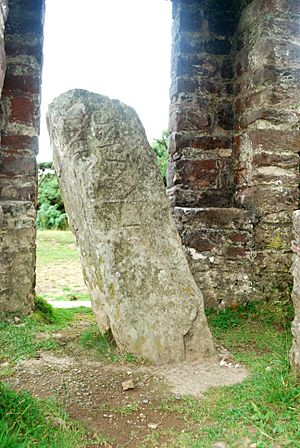Caratacus Stone facts for kids
Quick facts for kids Caratacus Stone |
|
|---|---|

Caratacus Stone, showing the inscription CARAACI NEPVS
|
|
| Location | Winsford Hill, Exmoor, Somerset, England |
| OS grid reference | SS88973355 |
| Built | Sub-Roman period (approximately sixth century) |
| Official name: Caratacus Stone | |
| Reference no. | 1021228 |
| Lua error in Module:Location_map at line 420: attempt to index field 'wikibase' (a nil value). | |
The Caratacus Stone is an ancient stone found on Exmoor in Somerset, England. It has special writing carved into it. People think this stone was made around the 6th century. That's about 1,500 years ago! Since 1925, it has been a scheduled monument. This means it's a very important historical site that is protected by law.
Contents
What the Stone Says
The writing on the stone is in Latin, an old language. It seems to say CARAACI NEPVS. But experts believe a special mark above one of the letters changes its meaning. They think it should be read as CARATACI NEPVS. This is because of a ligature, which is when two letters are joined together.
Meaning of the Inscription
The words on the stone can be translated as "grandson or immediate descendant of Caratacus". This is a big clue! Most people believe the stone was put up to remember someone. This person likely claimed to be a descendant of Caratacus. Caratacus was a famous British chieftain from the first century. He fought against the Roman invasion.
Missing Parts of the Text
It's possible that there was more writing on the stone. Over hundreds of years, weather can wear away stone. So, some of the original message might be lost forever.
History of the Caratacus Stone
The Caratacus Stone has been known for a very long time. The first time it was written about was in 1219. Back then, it was called "the Langeston." This was in a description of the Royal Forest of Exmoor.
Repairs and Discoveries
In 1890, a letter (the letter N) was missing from the stone's writing. But by 1919, the missing piece was found! It was then carefully cemented back into place. This helped to complete the inscription.
In 1906, a small shelter was built over the stone. This helps protect it from the weather. In 1937, archaeologists dug around the stone. They wanted to see if it was part of a burial site. Their digging showed that it was not connected to any burials.
Image gallery







